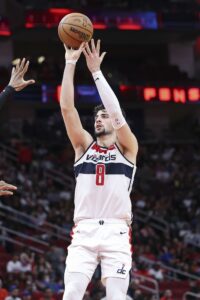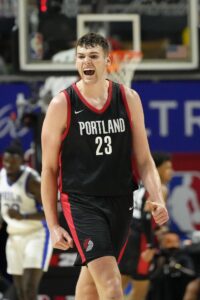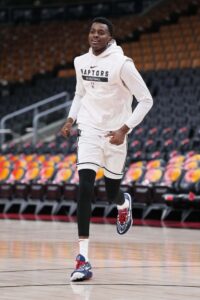Hoops Rumors is checking in on the 2024 offseason for all 30 NBA teams, recapping the summer’s free agent signings, trades, draft picks, departures, and more. We’ll take a look at each team’s offseason moves and consider what might still be coming before the regular season begins. Today, we’re focusing on the Portland Trail Blazers.
Free agent signings
- Devonte’ Graham: One year, minimum salary. Non-guaranteed. Signed using minimum salary exception.
- Henri Drell: One year, minimum salary. Non-guaranteed (Exhibit 10). Signed using minimum salary exception.
Trades
 Acquired the Timberwolves’ 2027 second-round pick; either the Pacers’ or Wizards’ 2029 second-round pick (whichever is least favorable); and the Knicks’ 2030 second-round pick from the Knicks in exchange for the draft rights to Tyler Kolek (No. 34 pick).
Acquired the Timberwolves’ 2027 second-round pick; either the Pacers’ or Wizards’ 2029 second-round pick (whichever is least favorable); and the Knicks’ 2030 second-round pick from the Knicks in exchange for the draft rights to Tyler Kolek (No. 34 pick).- Acquired the draft rights to Quinten Post (No. 52 pick) and cash from the Thunder in exchange for the draft rights to Oso Ighodaro (No. 40 pick).
- Acquired cash from the Warriors in exchange for the draft rights to Quinten Post (No. 52 pick).
- Acquired Deni Avdija in exchange for Malcolm Brogdon; the draft rights to Carlton Carrington (No. 14 pick); either the Trail Blazers’, Celtics’, or Bucks’ 2029 first-round pick (whichever is second-most favorable); the Warriors’ 2028 second-round pick; and the Trail Blazers’ 2030 second-round pick.
Draft picks
- 1-7: Donovan Clingan
- Signed to rookie scale contract (four years, $31,085,018).
Two-way signings
Departed/unsigned free agents
- Ibou Badji (Bucks)
- Moses Brown (unsigned)
- Ashton Hagans (unsigned)
Other moves
- Exercised Dalano Banton‘s 2024/25 team option ($2,196,970).
Salary cap situation
- Operating over the cap ($140.6MM) and below the luxury tax line ($170.8MM).
- Carrying approximately $167.1MM in salary.
- No hard cap.
- Full mid-level, bi-annual exceptions available.
- Three traded player exceptions available (largest worth $8,778,377).
- Note: The $8,778,377 exception expires on 9/27. The second-largest TPE is worth $6,875,000.
The offseason so far
After finishing the 2023/24 season with a 21-61 record, worst in the Western Conference, the Trail Blazers entered the offseason projecting to be a taxpayer in ’24/25, which wasn’t exactly ideal for a team still far away from contention.
As a result, Portland had two primary goals this summer: First, continue adding young talent to its core. And second, shed enough salary to get under the tax line and avoid paying a premium for a roster almost certain to finish in lottery territory again.
Armed with the Nos. 7, 14, 34, and 40 picks in the 2024 draft, the Trail Blazers were well positioned to add more prospects to their roster, but opted against keeping all of those draft assets, recognizing they could use one of those lottery picks to help address both of their offseason goals. Rather than hanging onto the No. 14 pick, Portland packaged it with Malcolm Brogdon, a future first-rounder, and a pair of second-round picks to acquire Deni Avdija from the Wizards.
While it may look like a significant price to pay for Avdija, Brogdon didn’t have a long-term place in a crowded Portland backcourt, this year’s draft class was considered weak, and the future first-round pick the Blazers surrendered is just a second-most favorable pick in 2029, meaning they’ll still hold a more favorable first-rounder in the spring of ’29.
Plus, even though Avdija is a four-year veteran, he just turned 23 years old this year and is on a team-friendly contract that he signed last fall prior to an impressive breakout season in 2023/24. The four-year, $55MM deal starts at about $15.6MM and descends from there, making it a relative bargain for a player who posted career highs in PPG (14.7), RPG (7.2), APG (3.8), FG% (.506), and 3PT% (.374) last season. The former Wizard immediately becomes a long-term building block in Portland.
The trade also ensured the Blazers will stay out of tax territory in 2024/25. Brogdon’s $22.5MM expiring contract exceeds Avdija’s ’24/25 cap charge by nearly $7MM, and the No. 14 pick would’ve received a salary just shy of $4.5MM, so Portland essentially trimmed eight figures worth of salary in the transaction.
 Besides acquiring Avdija, the only other major addition the Blazers made this offseason was drafting center Donovan Clingan with the No. 7 overall pick in June.
Besides acquiring Avdija, the only other major addition the Blazers made this offseason was drafting center Donovan Clingan with the No. 7 overall pick in June.
It was a somewhat curious choice, given that Portland has no shortage of centers already under contract (Deandre Ayton, Robert Williams, Duop Reath). But the Blazers are still early enough in their rebuild to favor a “best player available” approach to the lottery, and Clingan – who was widely considered a possible top-three pick leading up to draft night – presumably fit that bill for them.
It’s not as if the Blazers already have a star at the position either. Ayton is a former No. 1 overall pick, but he has been inconsistent, isn’t an elite rim protector, and didn’t cement his place as the long-term answer in the middle during his first year in Portland. Williams, meanwhile, missed most of last season due to knee surgery, and Reath projects as more of a second or third option on the depth chart.
Interestingly, after trading away the 14th overall pick in the draft, the Blazers also opted not to use either No. 34, which they traded to New York for three future second-rounders, or No. 40, which they sold for cash.
I was a little surprised that a rebuilding and cost-conscious Portland team didn’t hang onto at least one of those selections, which would’ve allowed them to add another rookie on the cheap. But the front office must feel as if there are already enough projects on the roster for the coaching staff to develop — six Blazers players, including lottery picks Scoot Henderson and Shaedon Sharpe, were selected in either the 2022 or 2023 draft.
Up next
The Blazers’ logjam at center makes them a logical candidate for a preseason or in-season trade. Ayton would be difficult to move due to his maximum-salary contract, but Williams is earning around the mid-level and could be an intriguing target if he’s able to show he’s back to 100% health.
The situation in the backcourt may not be best described as a “logjam,” but the Blazers are clearly hoping that Henderson and Sharpe will be their starting guards of the future. In the present, Anfernee Simons has the stronger résumé and probably wouldn’t be thrilled if he finds himself out of the starting five. That’s not to say that finding a taker for Simons is a top priority in the short term (there should be plenty of playing time to go around for all three guards), but it wouldn’t be surprising if his name pops up in trade rumors prior to February’s deadline.
Simons, Ayton, and Williams are all eligible for veteran extensions up until October 21, but are unlikely candidates to sign new contracts by that point — they each have two years left on their current deals, so if the Blazers do decide one or more of them are keepers, they could try to work out longer-term contracts during the 2025 offseason.
Jabari Walker is the least heralded but perhaps most viable extension candidate of the bunch. He’s entering the final year of his minimum-salary contract after averaging 8.9 points and 7.1 rebounds per game in a part-time role (23.6 MPG) last season.
As for the Blazers’ projected regular season roster, they’re currently carrying 14 players on guaranteed standard contracts and three on two-way deals, so barring trades, only the 15th standard spot looks up for grabs. Dalano Banton is probably the favorite for that last opening, with camp invitee Devonte’ Graham also in the mix.
 SEPTEMBER 14: The Lakers and free agent big man
SEPTEMBER 14: The Lakers and free agent big man